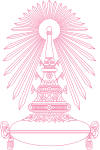
Windsor Palace was situated in Bangkok, Thailand, during the early twentieth century. Built on the orders of King Chulalongkorn (Rama V) to serve as the residence of Crown Prince Vajirunhis, the palace later became part of Chulalongkorn University but was later demolished to make way for the construction of Suphachalasai Stadium. The palace became known as such to foreign residents of Bangkok due to its partial resemblance to Windsor Castle, though it was also known to locals as Wang Klang Thung or Wang Mai.
History
Windsor Palace was commissioned by King Chulalongkorn in 1881 to serve as the residence of his eldest son, Prince Vajirunhis, who would later be named the first Crown Prince of Siam (Thailand). The palace was located on Sa Pathum Road (now Rama I Road) at the current location of Suphachalasai Stadium. Designed in Gothic Revival style by the Italian architect Joachim Grassi, its appearance reflects that of Windsor Castle in England, and the palace became known to contemporary expatriates as Windsor.[1] Locals called the palace Wang Klang Thung (Thai: วังกลางทุ่ง), lit. palace in the field, for its location, or Wang Mai (วังใหม่), which means new palace.[2] The latter name in turn gave rise to Wang Mai Subdistrict, which is part of Pathum Wan District and covers the area where the palace was located. The palace had three main storeys and a central staircase,[3] was built with imported marble, and internal decorations included neoclassical columns and statues.[2]

The palace's foundation stone was laid in November 1881, and construction was completed in July 1884. However, Prince Vajirunhis continued to live in the Grand Palace and had not moved into his new home when he died in 1895.[4] Following the prince's death, the palace was used as a school of cartography, and later on, agriculture.[5] When King Vajiravudh (Rama VI, who succeeded King Chulalongkorn) established the Civil Service College of King Chulalongkorn (later to become Chulalongkorn University) in 1911, ownership of the palace was transferred to the college and the palace became the seat of the college's School of Mechanical Sciences. In 1916 the college campuses were consolidated, and Windsor Palace served as the centre of the Prathum Wan Campus (which by now also hosted the Public Administration and Education Departments) while a new Administration Building (now the Faculty of Arts Building) was being constructed.[2]
With the formal establishment of Chulalongkorn University in 1917, Windsor Palace became the seat of the Faculty of Arts and Science. The building was modified to hold classes and laboratories, with a cadaver dissection lab built nearby. It was also here at the palace that Prince Mahidol Adulyadej instructed medical students in pre-clinical courses.[6][7] Four student dormitories were built near the palace building, and later became known as Ho Wang (หอวัง, lit. palace dormitory).[2][8] The name was adopted by the university's teacher-training school, which was established nearby and became known as Horwang Secondary School of Chulalongkorn University. Use of the palace ceased in 1935 when the area was requested for construction of the National Stadium. The faculty was relocated, and Horwang School moved to the site that is now Triam Udom Suksa School.[9]
Demolition and excavation

Following the Siamese Revolution of 1932 which abolished absolute monarchy, the property surrounding Windsor Palace was leased to the Ministry of Education's Department of Physical Education in 1935 to serve as the construction site for the National Stadium complex, with Suphachalasai Stadium at its core. The palace was subsequently demolished, and its existence faded from public knowledge.[2][5]
Part of the National Stadium complex was established as the Central Physical Education School, which later became part of Srinakharinwirot University's Faculty of Physical Education. Ownership of these buildings was transferred to Chulalongkorn University's School of Sports Science when their lease expired in 1997. Later during renovations by Chulalongkorn University, fragments of marble columns and statues were discovered, and it was concluded that they originated from the palace structure. These are now on display at the School of Sports Science.[10] Numerous marble fragments have also been found within the site of the National Stadium, but have been left lying around as debris. There have been calls for formal excavation and cataloguing, but no substantial developments have yet emerged.[7]
On the eightieth anniversary of the establishment of Chulalongkorn University in 1997, a set of commemorative postage stamps was issued. Windsor Palace featured in one of the designs.[3]
References
- ^ Pittayawattanachai, Piriya (2011). สถาปัตยกรรมของโยอาคิม กราซีในสยาม [The Architecture of Joachim Grassi in Siam] (PDF) (Thesis) (in Thai). Silpakorn University. Retrieved 23 December 2016.
- ^ a b c d e Chongkol, Sawat (17 February 2010). "วังวินด์เซอร์ (Windsor Palace)". Memorial Hall of Chulalongkorn University website. Chulalongkorn University. Retrieved 13 September 2011.
- ^ a b Napawongse, Chirayu (July–October 1997). "พระตำหนักวินเซอร์ (Windsor Palace)". Chamchuri (in Thai). 1 (2). Archived from the original on 27 February 2009. Retrieved 13 September 2011.
- ^ Pirasri Povatong (14 July 2019) [June 2005]. "วังใหม่ที่ปทุมวัน : ประวัติศาสตร์สถาปัตยกรรม "ความทรงจำอันเลือนราง"". Silpa Wattanatham (in Thai). Retrieved 10 November 2019.
- ^ a b Sangvichien, Sanjai (19 October 1985). "ประวัติที่ดินจุฬาลงกรณ์มหาวิทยาลัย (History of land property of Chulalongkorn University)". In Chulalongkorn University Faculty Senate Member Club (ed.). ขุมความคิด 3: อดีตถึงปัจจุบัน (Trove of Thoughts 3: Past to Present) (PDF) (published July 2010). pp. 14–15. Retrieved 13 September 2011.
- ^ Homsetthi, Kriangkrai (March–June 1999). "สมเด็จพระราชบิดา (The Prince Father)". Chamchuri (in Thai). 3 (1). Archived from the original on 27 February 2009.
- ^ a b "จุฬาฯรับ-เจ้าภาพสำรวจวังกลางทุ่งก่อนรวบรวมศิลปวัตถุไว้เพื่อศึกษา (Chulalongkorn U accepts proposal for research on Klang Thung Palace)". Thai Post (in Thai). 8 March 2010. Retrieved 13 September 2011.
- ^ "หอวัง (Palace Dormitory)". Chulalongkorn University Student Affairs Office website (in Thai). Chulalongkorn University Student Affairs Office. Retrieved 13 September 2011.
- ^ Malakul, Pin (1989). อัตชีวประวัติของหม่อมหลวงปิ่น มาลากุล (Autobiography of Mom Luang Pin Malakul) (in Thai) (2006 reprint ed.). Bangkok: Thepnimit Press (published 2006). pp. 127–129.
- ^ "วังกลางทุ่งหรือวังใหม่ (Klang Thung Palace aka. New Palace)", Information sign (in Thai), Chulalongkorn University.




Recent Comments